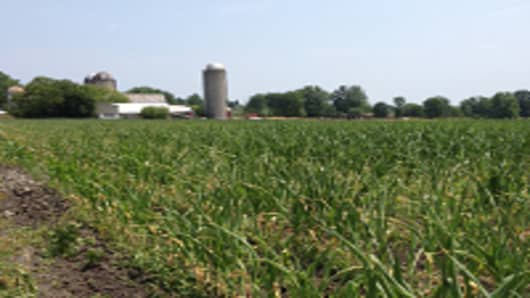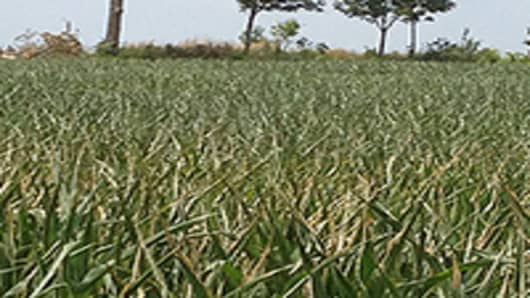The size and quality of the U.S. corn crop continues to deteriorate as scorching heat in the corn belt threatens the crop during its critical pollination, or "tasseling" stage.
The amount of the corn crop that is in good to excellent condition keeps shrinking, now making up 48 percent of the crop compared to 56 percent last week and 63 percent the week before.
The USDA data, released Monday, also showed a decline in the quality of the soybean crop to 45 percent good to excellent, from 53 percent last week.
“Corn should be seven to nine foot tall right now,” said Rich Nelson, head of research at Allendale. “All these reports of three to six foot corn is a little disappointing.”
Corn is pollinating for the next couple of weeks in much of the Midwest, and it needs cooler, wetter weather but the forecast still looks hot and dry, in a big growing area from Ohio to Iowa.
"Tasseling" or pollination determines kernel formation and quality. Each silk pollinates one kernel of corn.
"If there isn't enough rain to make the silk come out of the end of the corn cob, the pollen will have nothing to pollinate," said Ashley Gulke, analyst with Gulke Group and a farmer. "It needs water to fill that kernel, even after pollination."
"It's not as important a phase for soy beans. They actually have some time before they need rain," said Gulke, also president and active farmer for High Heels and Cowboy Boots, a North Dakota farming corporation.
The USDA forecast a bumper crop for this year, planted on the highest acreage since 1937. But the heat and lack of rain has damaged some of the crop already, and analysts have been paring back expectations.
“It’s amazing. In the last two weeks, we’ve taken a corn crop that looked like it was going to be 14.7 billion bushels in excellent condition. You put 105 degree temperatures on it. You’ve had no rain upon that corn crop, and suddenly you’ve probably taken about a billion bushels out of it," said Dennis Gartman of Gartman Letter on "Fast Money."
"Corn prices have gone up almost $1 per bushel and they may go up even more. It depends what happens in the next 10 days," Gartman said. "We’re at tasseling time. We’re at the time when the corn crop actually sets itself, and if we don’t get some rain here very soon, what was a great crop suddenly becomes a very diminished crop.”
Gulke this week took a road trip through a portion of the growing region, visiting farms in Illinois, Wisconsin and Minnesota. The Minnesota fields were in far better shape than many in Wisconsin and Illinois, she said.
Until she saw the Minnesota fields, she said she was more bullish on corn prices.
"The USDA is 8 percent more negative (this week) on both corn and beans, and that's probably the most accurate estimate you'll get, and they're evening out the exceptional crops and the disaster crops," across the growing region, Gulke said.
She said in one area in Wisconsin, the fields look so bad she did not recognize the crop initially.
“Just saw a field, thought it was onions—nope corn,” Gulke sent in a quick email.
Corn futures for December were more than 6 percent higher for the week so far, closing Tuesday at $6.74 per bushel. That follows last week’s double digit gains on worries hot, dry weather will result in a smaller yield.
Nelson said the crop is the worst since 1988, but not nearly as bad as it was then. At that time, just 23 percent of the crop was good to excellent at this time of year, and the drought was national. Nelson expects this year’s crop to yield 145.3 bushels per acre, well below the 166 expected by USDA. He said the year’s trend is 161, and that would be a 10 percent decline from trend. In 1988, there was a 28 percent decline from trend.
Gulke said during her trip through Illinois, there was talk of some farmers swapping out corn to plant soybeans.
Nelson said he heard the same and expects it will be a small amount of acreage that gets replanted, but only after rains start to fall.
Follow Patti Domm on Twitter: @pattidomm
Questions? Comments? Email us at marketinsider@cnbc.com





